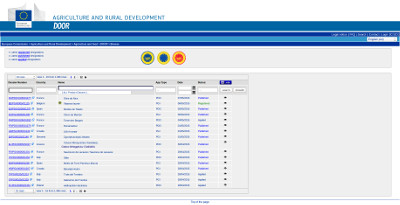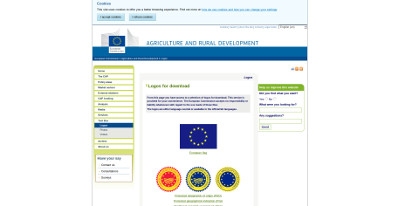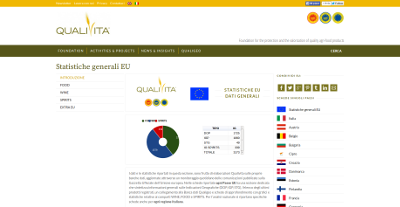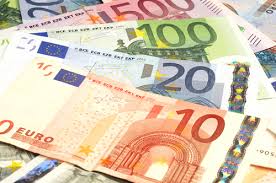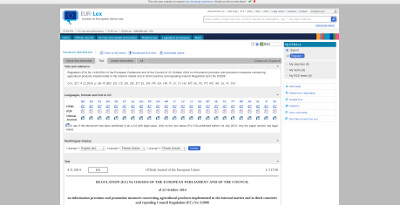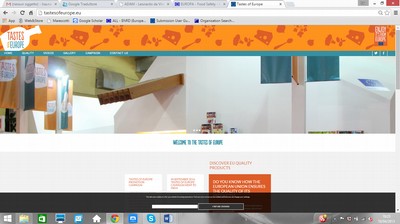Overview: The European Union Guarantee
During the last 20 years, there has been a proliferation of protected designations of origin, and protected geographical indication labels
Nowadays, there is a need to capitalize on the unique features of regional products.
The European Union guarantees the quality of agricultural products and foodstuffs through regulations and law.
Since 1992 the European Union has developed a scheme to identify and protect names of quality agricultural products and foodstuffs.
The following definitions still represent the basis of voluntary certification system since that time.
Here below you can find the basic definitions and logo typologies of geographic indications
Protected Designetion of Origin
is a name which identifies a product:
- originating in a specific place, region or, in exceptional cases, a country;
- whose quality or characteristics are essentially or exclusively due to a particular geographical environment with its inherent natural and human factors; and
- the production steps of which all take place in the defined geographical area.
Protected Geographical Indication
is a name which identifies a product:
- originating in a specific place, region or country;
- whose given quality, reputation or other characteristic is essentially attributable to its geographical origin; and
- at least one of the production steps of which take place in the defined geographical area
Traditional Speciality Guaranteed
A name shall be eligible for registration as a “traditional speciality guaranteed” where it describes a specific product or foodstuff that:
- results from a mode of production, processing or composition corresponding to traditional practice for that product or foodstuff; or
- is produced from raw materials or ingredients that are those traditionally used.
Ask yourself
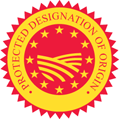
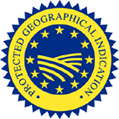
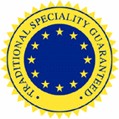
The role of Traceability in quality certification processes
Dating from 2003, EU policy centers on the concept of traceability both of inputs (e.g. animal feed) and of outputs (e.g. primary production, processing, storage, transport and retail sale). Member States agree standards to ensure food hygiene, animal health and welfare, and plant health and to control contamination from external substances, such as pesticides.
Currently a new regulation has been set up to give consumers better access to clear, comprehensive and reliable food information (from 13th Dec 2014)
Protect your products!
Rigorous checks are carried out at every stage and imports (e.g. meat) from outside the EU are required to meet the same standards and go through the same checks as food produced within the EU.
The last published Regulation on quality schemes for agricultural products and foodstuffs is the: No 1151/2012 of 21st November 2012
The first article of this Regulation underlines the aim to help producers to communicate the products characteristics and farming attributes of their products and foodstuffs to buyers and consumers, ensuring:
- fair competition for farmers and producers of agricultural products and foodstuffs having value-adding characteristics and attributes;
- the availability to consumers of reliable information pertaining to such products;
- respect for intellectual property rights;
- the integrity of the internal market.
The measures set out in this Regulation are intended to support agricultural and processing activities and the farming systems associated with high quality products, thereby contributing to the achievement of rural development policy objectives.
Protect your production with voluntary certification to assure your clients that they are buying a superior quality product, as it is controlled by a third party and also they are collaborating to preserve traditions, local produce, biodiversity.
Important to note:
EU law lays down stringent requirements with the double intent of protecting both consumers and farmers.
(Learn more about EU quality schemes in Module 4 – Unit 2)
You can find the EU best practice guidelines for voluntary certification schemes in your own language click on the following link:
NOT only European GI products exist across the World
15 of the total registered products come from non-EU countries. In 2013 Thailand and Andorra recorded for the first time a product leading to 6 the number of extra-EU countries that use the EU quality certification system, together with China, Colombia, India and Vietnam.
| Colombia | Café de Colombia PGI |
| India | Darjeeling Tea PGI |
| Vietnam | Phu Quoc PDO |
| China | Pinggu Da Tao Dongshan Bai Lu Sun Yancheng Long Xia Zhenjiang Xiang Cu Jinxiang Da Suan Longjing cha Guanxi Mi You Shaanxi ping guo Lixian Ma Shan Yao Longkou Fen Si |
| Thailand | Khao Hom Mali Thung Kula Rong-Hai PGI |
| Andorra | Carn d'Andorra PGI |
A special case: the Outermost Regions
Outermost regions are States within the EU which are severely disadvantaged because of their remoteness and insularity and difficult geographical and meteorological conditions. They include the French Overseas Departments (Guadeloupe, French Guiana, Réunion and Martinique), the Azores and Madeira as well as the Canary Islands.
The logo enables the consumer to identify and recognise quality agricultural products originating in the outermost regions. The national authorities of France, Spain and Portugal introduced in their respective programmes for agriculture for outermost regions (POSEI = Programmes of specific options for isolation and insularity) specific measures allowing the financial support of quality products that respond to pre-established requirements, in particular in the sectors of wine as well as of livestock and meat production.
News from Europe!
In recent years, this policy has been pursued using several tools, such as: fund investments, projects, research, regulations and dissemination with the help of member states government, associations and other stakeholders.
The last product of these effort was published in the Official Journal the 4th November 2014: the European Commission welcomes the new Regulation on information provision and promotion measures concerning agricultural products implemented in the internal market and in third countries and repealing Council Regulation (EC) No 3/2008.
The EC proposal includes an increase in the aid allocated to promotion initiatives of European agriculture.
According to this regulation, European aid should increase progressively from EUR 61 million in the 2013 budget to EUR 200 million in 2020.
Under the new rules, national co-funding will disappear, with EU co-financing rates raised to 70% for simple programmes presented by an organization from one Member State, 80% for multi-Member State programmes and programmes targeting third countries, 85% for crisis measures.
The new regulation entered into force on 1st December 2015.


The EU Promotion Campaign
The EU continues to support initiatives with publications and web sites properly dedicated to European certified products. The policy is oriented to promote the consumption of European foodstuffs not only amongst the EU member States, but also outside its boundaries.
With the slogan 'Enjoy, it´s from Europe', the policy aims to help the sector's professionals break into or consolidate international markets and make consumers more aware of the efforts made by European farmers.
Where you can find information about certified products?
The DOOR ("Database of Origin and Registration") database includes product names for foodstuffs registered as PDO, PGI or TSG as well as names for which registration has been applied.
http://ec.europa.eu/agriculture/quality/door
E-BACCHUS is the database on geographical indications protected in the European Community for wines originating in Member States and third countries.
http://ec.europa.eu/agriculture/markets/wine/e-bacchus/index.cfm?event=pwelcome&language=EN
Are you Organic?

http://ec.europa.eu/agriculture/organic/index_en.htm
When “certified” doesn't mean “restricted”
In the last years, also the icon of globalized food present everywhere in the world focuses each national advertising campaign on introduction of local certified products. Their goal is to be able to attract those consumers who normally are not in their target, because they used to consume superior quality food compared to that offered in a typical fast food.
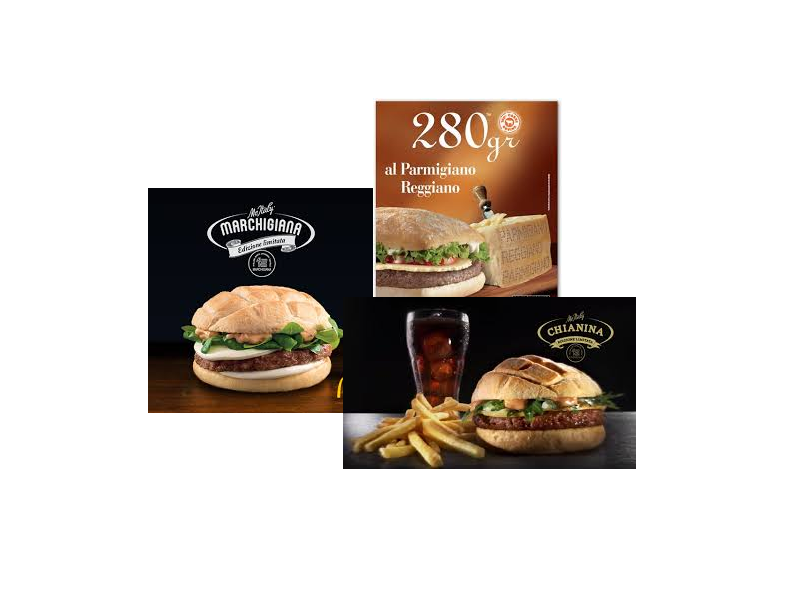

This communication (website) reflects the views only of the author, and the Commission cannot be held responsible for any use which may be made of the information contained therein.



